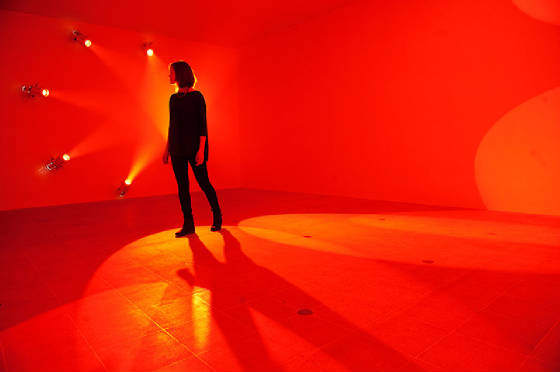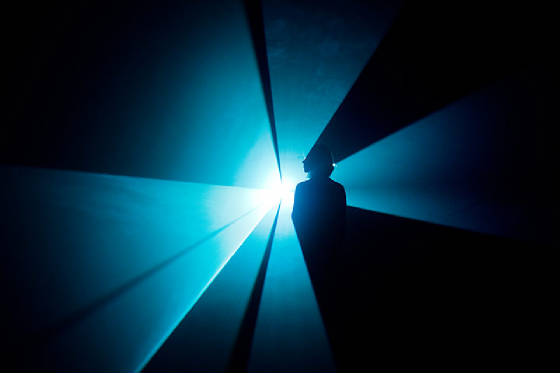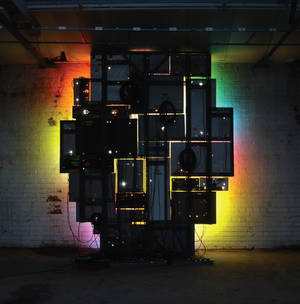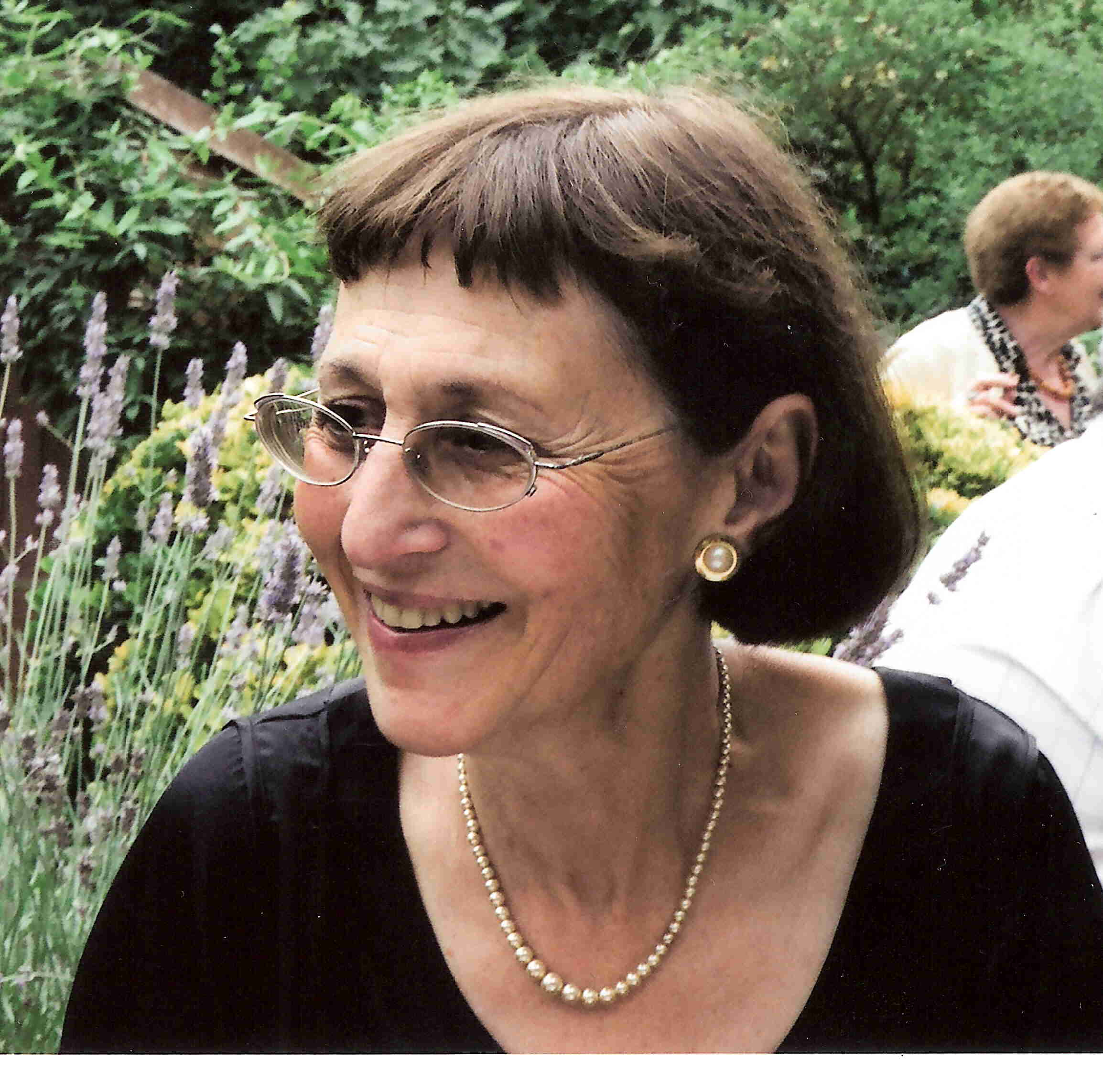Josef Albers is once said to have handed the critic and champion of Abstract Expressionism Harold Rosenberg a note
on which was written ‘Angst is dead.’ This apocryphal event probably took place in the mid-sixties at a time when
minimalism, kinetic and op art represented the cutting edge of the avant-garde and the emphasis was on formalist analysis
of geometric shapes and the interaction of colour. Perception rather than existential psychologising was the order of the
day. The exhibition The Responsive Eye held at the Museum of Modern Art in New York in 1965 confirmed the trend of
using geometric abstraction to create a new sense of movement that could be both virtual and three-dimensional. However
it was the combination of movement with light that has proved to be one of the most adventurous areas of artistic research
since the sixties, when Dan Flavin began to experiment with fluorescent light fittings that alter our perception of space
and James Turrell and Doug Wheeler were manipulating light so as to create breathtaking spatial illusions. These American
artists are represented here together with other artists of their generation, such as Francois Morellet in France and Carlos
Cruz-Diez in Venezuela, as well as a whole new generation of artists who concentrate on opticality using light and colour
as their chosen medium. Light Show as spectacle presents us with a wide spectrum of artists and as large a range of
art works some of which concentrate on modifying space, others on manipulating changes in colour and luminosity. Although
the exhibition is enchanting the eye, it has another dimension that alludes to darker matters.
The origins of this relatively new category of art can be traced back to the late nineteenth century
and Muybridge’s and Marey’s photographic investigations into movement that had a direct impact on many artists,
especially Degas with his interest in successive images in relation to what he observed at the race course and ballet. Futurism’s
focus too was on isolating visual equivalents of speed and movement and expressing this new plastic dynamic in their paintings.
However Duchamp was the first artist to tackle the idea of movement conceptually. In 1913 his painting Nude descending
a staircase which had been rejected by the Salon des Independents in the previous year, won great notoriety at the Armory
Show in New York. Duchamp likened his picture to a virtual machine’s continuous downward movement and described
it not as a painting but as an ‘organisation of kinetic elements – an expression of time and space through the
abstract presentation of movement.’ Duchamp continued his exploration of movement with his mechanised Rotoreliefs,
which were all part of his attempt to downgrade retinal art in favour of a more conceptual study that includes the spectator.
This, as we shall see, represents an ever more important aspect of this type of kinetic sculpture that can be based on both
mechanical and natural forces and embraces both predictable and unpredictable changes that depend on the viewer’s response. 
Ann Veronica Janssens, Rose
But for all of Duchamp’s genius and wit, it is to Moholy Nagy that we should pay deference. His Light Machine,
the idea for which was based as early as 1922 on the activation of space by a dynamic system of forces that was intended to
replace ‘the static principle of classical art with the dynamic principle of universal art’ was not completed
till 1929. His main resolve was very much part of the Bauhaus credo to effect a positive transformation of the machine, and
the sculpture brought together many aspects of kinetic art. But what really distinguished it was its combined impact on the
environment as a spectacle of moving lights. A mechanised sculpture made of polished metal, it reflected the light it threw
out in a continuous cavalcade of abstract patterns by dint of the 130 bulbs of different colours housed within its carapace.
It can be looked upon as the prototype of many of the installations in this exhibition with its emphasis on seemingly irregular
and random movement that come into play as part of a program of projected and reflected light. It is this use of artificial
light married now to digital technologies that characterise the work of many of the new generation of artists who, working
at the interface between art and science, sculpt and create illusions with light. While there have been many artists who have
continuously worked in this area, there have been times when their contributions were eclipsed by other more fashionable art
movements. Post-Modernism with its emphasis on narrative and deconstruction tended to do just that and so a pattern has emerged
with periods when kinetic art that was increasingly focusing on luminosity was overlooked. This pattern has much to do with
comparatively recent digital developments in science and technology and the discovery of new materials; the use of programmed
Light-Emitting Diodes (LED) for instance, catching up with artists’ vision and vice versa, with the artist’s vision
no longer confined to a single screen but able to inhabit three dimensions. One example is Jim Campell’s Exploded
View, 2011, which is made up of more than a thousand LED bulbs and where a recognisable image depends on the movement
of the viewer walking past the seemingly random grouping of lights. Another is Leo Villareal’s Cylinder, 2011,
which is made up of 19,600 white LED lights that create waves of unpredictable programmed patterns many of which mimic natural
movements.
Anthony McCall also comes to mind. An artist originally interested in avant-garde cinema, a background he shares
with Nancy Holt and Cerith Wyn Evans who worked with Derek Jarman before turning to light installations, McCall quit the art
scene for twenty years before returning to concentrate on installations made up of projected light. You and I, Horizontal, 2005, is essentially cinema minus the screen. Made up of a projected beam of light plus
a haze machine it is computer programmed to produce a luminous cone shaped sculpture with which the spectators can engage
by walking around and through, their bodies modifying its shape and thus generating patterns in the shafts of light that take
on an almost surreal density; this objective to materialise light and make the invisible visible is shared by many of the
24 artists. Ann Veronica Jensson also works with light beams, but unlike McCall’s the majority of her installations
concentrate on colour. Her Rose, 2007, uses intersecting light projections and haze to
reveal a pulsating seven-pointed star. Many other works in the exhibition share the immersive character of her installation
that by emphasising this ephemerality require the spectator to respond to perceptual changes that take time to take effect.
Conrad
Shawcross is one of the youngest artists. For Shawcross sculpture represents the interface of his many interdisciplinary interests;
he regards himself as a thinker and a maker. This particular piece was directly inspired by an idea taken from the scientist
Dorothy Hodgkin’s work on crystal radiography, which prompted his interest in shadows. His installation Slow
Arc inside a Cube, 2009, refers back to Moholy Nagy’s Light Machine consisting as it does of an articulated
arm fitted with a halogen light housed in a metal meshed cube that describes a diagonal movement from one corner to another.
It thus refracts a constantly expanding and contracting grid of shadows on to the walls which the artist describes as a radiant
geometry. There is here a willed allusion to the allegory of Plato’s Cave that simulates our limited experience of reality,
i.e. the shadows we see and interpret as reality within the cave are dependent on what, unbeknown to us, is taking place outside
the cave but which we cannot locate. Shawcross seems to want to reinforce the dislocation between the two dimensions of reality.

You and I Horizontal (2005)
by Anthony McCall
Photo: Linda Nyland
Perhaps philosophically less challenging but potentially equally perplexing is the use of
the humble light bulb by a number of artists. Katie Paterson has devised a way of collecting moon light – an increasingly
rare commodity in our urban twenty-four hour culture – and in this way translate the ephemeral into the material. A
single light bulb floods its ambient space with the blue-ish light of the full moon that is beautiful and yet sadly pathetic.
The solitary light bulb is backed up by a separate array of bulbs calculated to provide a lifetime’s supply of moonlight.
The way Paterson’s work juxtaposes the poetic and the mundane is reminiscent of dadaist and surrealist stratagems to
imbricate art with the humorous agenda of pseudo-science. On the other hand Bill Culbert’s Bulb Box Reflection 11,
1975, presents the viewer with what seems an optical impossibility: the reflection of a light bulb that is lit up whereas
the original is not. Initially a painter Culbert, a New Zealander who studied at the Royal College of Art in London, began
his art practice in 1968 experimenting with electricity. But his use of found or ready made objects and his aim to capture
the unexpected and awaken a sense of mystery again allies him with a brand of Surrealism but one that is able to reconcile
itself with the industrial optimism of Moholy Nagy. A similar comic subtext is very much to the fore in Fischli and Weiss
who are very well known for their picaresque installations that are characterised by a sense of child-like fun but depend
on carefully crafted and programmed sequences of mishaps; simple events leading to complex ones highlight the role of chaos
theory between emergence and entropy. In Green Ray, which alludes to a film by Eric Rohmer, the most humble of items,
a torch directed on to a plastic cut-glass cup placed on a motorised cake stand, throws up an arabesque of patterns by way
of a half celebratory half sardonic tribute to Moholy Nagy’s Light Machine. Light
engenders darkness and darkness light. We have to go down narrow darkened corridors to view Turrell’s Wedge and
Doug Wheeler’s suspended square of light and then have the patience to become aware of subtle changes. With so much
light there is of course much to dazzle the eye but also much to baffle and perplex it; often it’s not possible to work
out the mechanism behind the installation. We become aware of changes in colour in Carlos Cruz-Diez’s wonderful Chromsaturation,
2008, but are unable to satisfactorily account for these modifications which are equally dependent on our perception as on
its science-based mechanics and programming. There is a strong element of the fairground or magic show underlying many of
the installations, e.g., Leo Villareal’s Cylinder, 2011, as well as a temptation to slip into a metaphysical
or even mystic state of mind. But in some cases, e.g. Cerith Wyn Evan’s columns, what at first sight seems a delicate
tracery or column of light turns out on closer inspection to be obsolete strip lights that emit heat as well as light and
have a dangerous aura about them. David Batchelor’s Magic Hour, made up of a stacked light boxes picked up from
the streets, also refuses to fall into a metaphysical category. Colour flooding out from his light boxes hits the wall, while
the viewer is presented with the blank backs of the unglamorous monitors caught up in a jumble of tangled and twisted electric
wires. The work speaks of entropy, the brilliant colours functioning like some end game glowing in the synthetic twilight
of a science fiction cityscape, recognisable as our own.
Cylinder
II (2012) by Leo Villareal
Most of Light Show is entertaining or uplifting though
some might say it is facile – Olafur Eliasson’s strobe dependent Model for a Timeless Garden for instance
can be taken as a model of a false paradise. But the curators have wisely I think included a darker side, for angst is not
dead after all. Unlike the majority of art works on display Jenny Holzer’s Monument, 2008, is forthrightly didactic.
A well known public artist who appropriated billboards in order to proclaim her own political messages and social truisms,
Holzer has been using light projections since the late eighties in an attempt to integrate political narrative into the sphere
of fine art. Her aim is for art to speak as explicitly as possible. For all its pink and purple prettiness, Monument delivers
an unremitting message featuring declassified US government texts that relate to the ‘war on terror’ and war crimes
at Abu Ghraib prison and Guantanamo Bay. Less explicit but equally hard hitting, and to my mind more convincing because of
its experiential aspect, is Ivan Navarro’s Reality Show. A socio-political sculpture which uses a minimalist
structure made up of industrially produced materials, it brings into question the relation between sight, surveillance and
power. The sculpture is made up of a mirrored phone box that places the viewer in the position of both surveyor and surveyed.
Whereas from the outside we can observe the occupant, once inside the box it is impossible not only to see out but even worse
impossible to see one’s own reflection. This virtual ‘disappearance’ is exacerbated by a terrifying infinity
of ever repeating reflections at floor and ceiling levels that suggests the loss of self that was the fate of ‘the disappeared’
during the years Pinochet ruled Chile.
During the sixties, kinetic art enjoyed a high profile. Science was regarded as a talisman to solve
society’s problems. Technology, especially, was wedded to a new progressive social vision; in the UK, Harold Wilson’s
‘white heat of technology.’ In South America, especially, kinetic and light sculpture retain their initial utopian
dimension as a means of creating social art and thus reaching a far wider public. Despite the fact that much of this initial
optimism has eroded, and that from the seventies installation and performance artists tended to concentrate on non-illusionistic
artwork that connected them to wider aspects of life, artists have continued to experiment with and investigate questions
of opticality and luminosity. The syntax may have stayed the same but with the transparency beloved of the heirs of the Bauhaus
revealed, in some cases, as complicit with surveillance, it seems that the message has become more complex and gained a political
voice that repositions it closer to the critical wing of the avant-garde.
©
Anna Leung April 2013

Magic Hour by David Batchelor

Anna
Leung is a London-based artist and educator now semi-retired
from teaching at Birkbeck
College
but taking occasional
informal groups to current art
exhibitions. Light Show is at the Hayward Gallery in London from 30 January 2013 - 6 May 2013.
|
